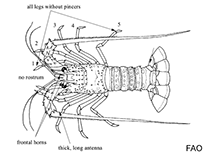Palinustus waguensis Kubo, 1963
Japanese blunthorn lobster| Native range | All suitable habitat | Point map | Year 2050 |

|
| This map was computer-generated and has not yet been reviewed. |
| Palinustus waguensis AquaMaps Data sources: GBIF OBIS |
Google image | No image available for this species;
drawing shows typical species in Palinuridae.
Classification / Names Populärnamn | synonymer | CoL | ITIS | WoRMS
Malacostraca | Decapoda | Palinuridae
Environment: milieu / climate zone / djupintervall / distribution range Ekologi
; djupintervall 72 - 180 m (Ref. 4), usually 72 - 84 m (Ref. 4). Tropical; 36°N - 8°S, 72°E - 141°E (Ref. 4)
Distribution Länder | FAO områden | Ekosystem | Förekomster | Utplanteringar
Indo-West Pacific.
Length at first maturity / Size / Weight / Age
Könsmognad: Lm 9.6, range 9 - ? cm Max length : 14.0 cm TL hane/ej könsbestämd; (Ref. 122082); common length : 10.0 cm TL hane/ej könsbestämd; (Ref. 4)
Life cycle and mating behavior Könsmognad | Reproduktion | Lek | Eggs | Fecundity | Larvae
Main reference
referenser | Koordinator | Medarbetare
Sekiguchi, N. and S. Okubo 1986 Notes on Justita japonica (Kubo, 1955) and Palinustus waguensis Kubo, 1963 (Decapoda, Palinuridae). Proceedings Japanese Society systematic Zoology. 34:19-26 + figure 1. (Ref. 191)
IUCN Red List Status
(Ref. 130435: Version 2025-1)
CITES status (Ref. 108899)
CMS (Ref. 116361)
Threat to humans
Human uses
Fiskeri: av potentiellt intresse
| FishSource |
Verktyg
Ytterligare information
Max. ages / sizes
Length-weight rel.
Length-length rel.
Length-frequencies
Mass conversion
Abundans
Internet-källor
BHL | BOLD Systems | CISTI | DiscoverLife | FAO(Publication : search) | Fishipedia | GenBank (genome, nucleotide) | GloBI | Gomexsi | Google Books | Google Scholar | Google | PubMed | Tree of Life | Wikipedia (Go, sök) | Zoological Record



